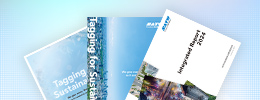At the SATO Group, we see employees as one of our greatest assets and the source that sustains the added value we provide through our business model. For the HR activities and initiatives we manage which include recruitment, placement, training/development, performance appraisal, compensation & benefits, and workstyle innovation, we make sure to base them on the principles of mutual respect and diversity, and align them with our corporate values.
Materiality
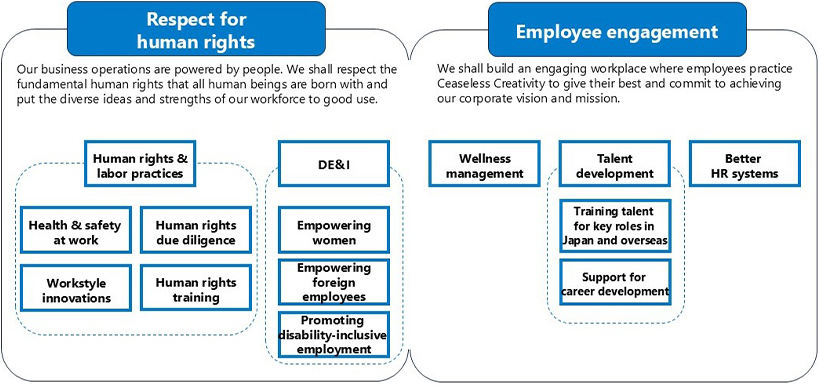
We have recently redefined our materiality assessment to include respect for human rights and employee engagement. By working on these material social topics, we hope to build a workplace where we match diverse employees to their roles and empower them to grow and thrive under strong HR governance. We understand that our Japan and overseas offices face different HR challenges, and are making efforts to improve how we manage human capital at the group level.
Human capital management: Aligning our talent portfolio with how we do business
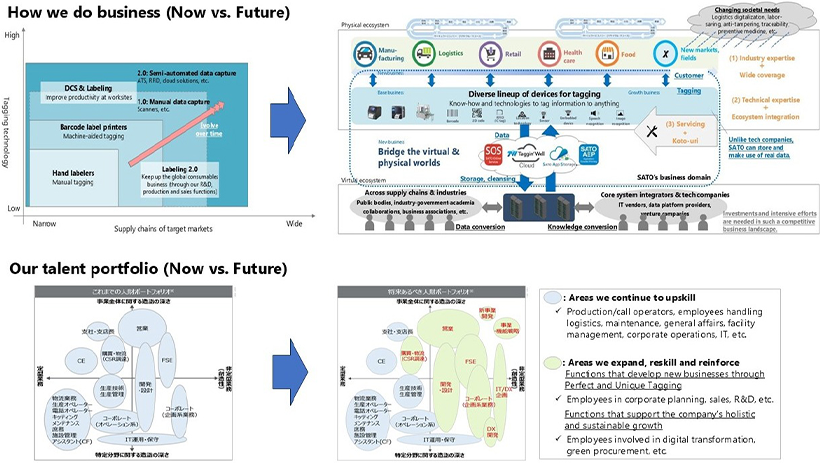
To create value for customers and help solve shared challenges in society, we plan to reach new markets/domains and expand our business through Perfect and Unique Tagging,1 which involves using RFID and various technologies and devices to tag data to everything to connect it seamlessly and bridge the physical and digital worlds. This new way of doing business and raising our corporate value requires upskilling some areas of our workforce while expanding, reskilling and reinforcing those areas that develop new businesses and support the company's holistic and sustainable growth. It also requires cultivating a culture of innovation. We start by empowering employees to practice corporate values in their daily work and hone our competitive advantage of genbaryoku2 to ensure they are self-reliant and self-determining to think and act proactively to initiate changes.
- 1.We are taking tagging — physically attaching identifiers to know the status of things and people — to the next level as part of realizing the 2030 vision outlined in our FY 2024 to FY 2028 medium-term management plan.
- 2.Our core competency of going directly to customers' worksites to understand their operations, grasp their core issues and deliver the optimal solution.
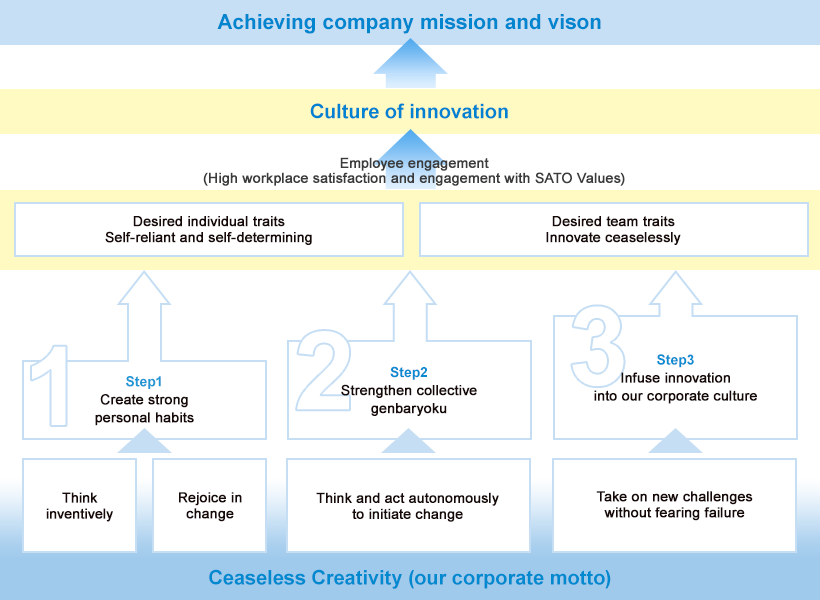
Our employees have developed strong personal habits of thinking inventively and rejoicing in change in their daily work. When the entire organization thinks and acts autonomously to initiate change, it strengthens our core competency of genbaryoku. And when employees take on new challenges knowing what is expected of them and their team, it promotes the exchange of diverse perspectives and values to spark innovation. We invest in human capital, hoping to infuse innovation into our corporate culture.
Process for building stronger human capital
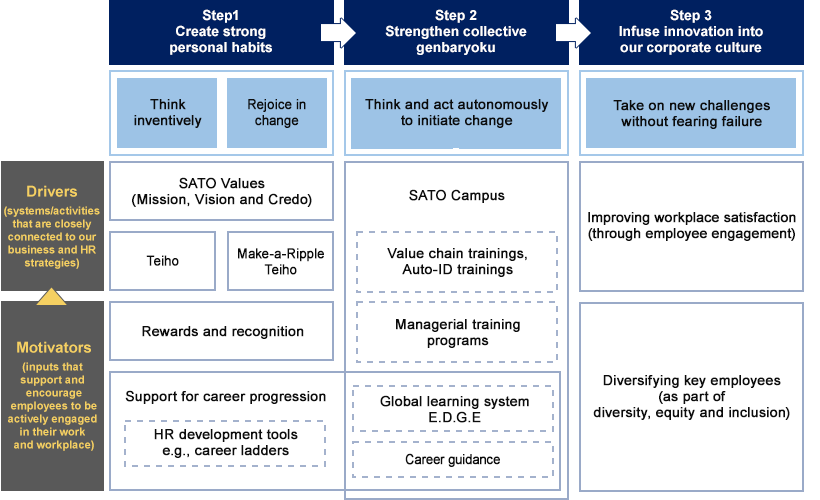
This three-step process is based on various drivers (systems/activities that are closely connected to our business and HR strategies) and their motivators (inputs that support and encourage employees to be actively engaged in their work and workplace). The following sections explain how we provide opportunities for employees to develop their skills and capabilities and put them to use to reinforce Steps 1 and 2.
Step 1: Create strong personal habits
Create strong personal habits

SATO Values
At the SATO Group, we believe that our competitiveness lies in the strengths of the individual. This is why we commit to “Building people, Building business,” with our corporate values as its foundation.
Building on our corporate motto “Ceaseless Creativity” penned by founder Yo Sato, we have developed our corporate culture, values and code of conduct over time into what we now call SATO Values. As we expand our business globally, spreading SATO Values to guide our decisions and behavior is more important than ever.
This is why we established SATO Values Office in 2016 and went on to appoint over 50 promotion leaders, selecting from group subsidiaries worldwide to serve as “ambassadors” to impart to their coworkers the company's reason for being (Mission) and what we aim to achieve (Vision). They conduct various activities in their respective countries/regions, one being SATO Values workshops, whereby they work off of a training program that is developed/revised every year to facilitate discussions using workshop materials that are translated into 15 languages. Among the leaders themselves, they also hold meetings and exchange information with one another whenever necessary.
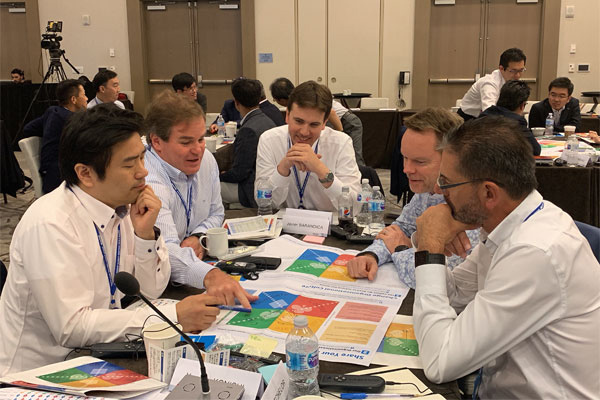 Scene from a SATO Values workshop
Scene from a SATO Values workshop
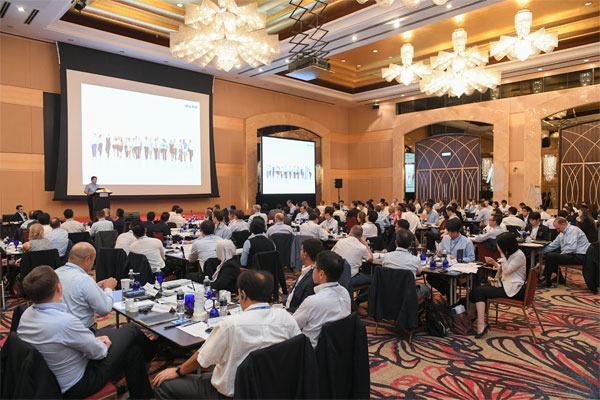 Workshop at the SATO Group Summit, a conference attended by leaders around the world
Workshop at the SATO Group Summit, a conference attended by leaders around the world
Teiho
Teiho is an in-house insight sharing system through which employees write (within a set word count) short daily “reports on original ideas, innovations and proposals aimed to make the company better and on how to put them into action,” and submit them directly to the top management.
Started in Japan over 40 years ago as a cornerstone of our corporate motto and now used in group companies around the world, the system sets the ground for rejoicing in change and serves to raise employee awareness on detecting areas of improvement to unlock their creativity for initiating big and small changes to grow business sustainably.
Teiho statistics
| FY 2024 | |||
|---|---|---|---|
| Japan | Overseas | Total | |
| Reports submitted | 439,157 | 66,890 | 506,047 |
Make-a-Ripple Teiho
In FY 2022, we took a step further by adding the new “Make-a-Ripple” Teiho in Japan to let employees raise ideas specific to their department for consideration by their immediate superiors. It gets its name from the opening lyrics of our company song, which uses the metaphor of a pebble thrown into a pond to show how small changes lead to bigger ones.
Make-a-Ripple Teiho shows employees that everyone can make a difference and gives them a sense of accomplishment from seeing their ideas turn into reality. It promotes a culture of proactivity and creative improvements, which we aim to cultivate to inspire changes, take new challenges and make working at SATO fulfilling for all employees.
Make-a-Ripple Teiho statistics
| FY 2024 | |
|---|---|
| Reports submitted | 770 |
| Reports that led to positive changes | 125 |
Example of employee idea from Make-a-Ripple Teiho:
Improve the customer experience for demo unit users
Changes made: After unpacking new printers at customer sites, our customer engineers now bring back the boxes and cushioning materials so that we can reuse them to pack printer demo units when their packaging gets damaged or old.
Teiho
- In Japan, about 2,000 employees submit Teiho reports daily. After screening, some tens are read by the management, who sends out instructions for departments/members to follow up on necessary improvements
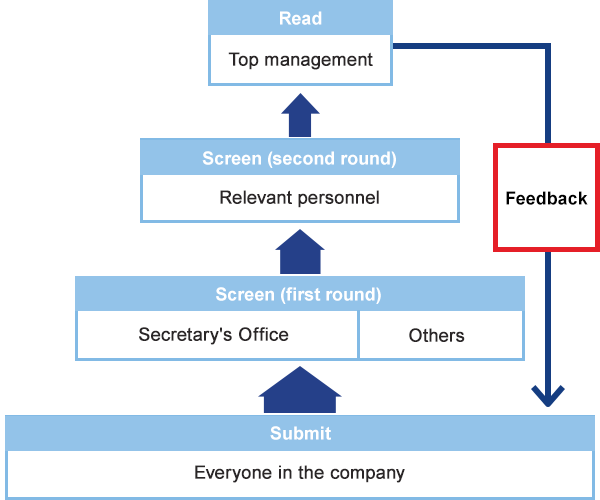
Make-a-Ripple Teiho
- Employees submit Make-a-Ripple Teiho reports, which managers promptly consider within their teams and decide on implementation using a set-aside budget.
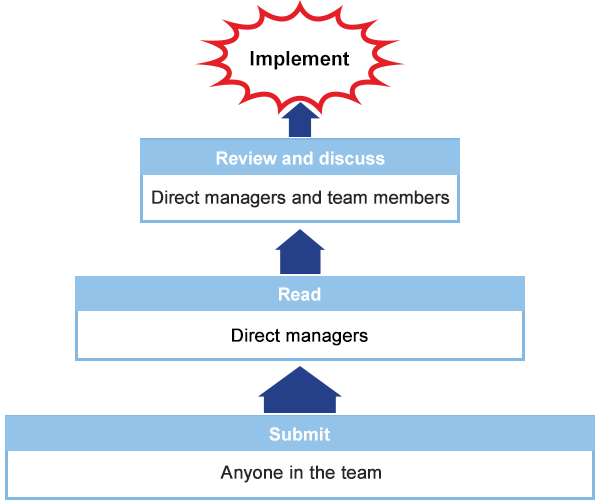
Rewards and recognition
We present different Credo, Teiho and invention awards for recognizing Ceaseless Creativity. All awards come with a monetary prize and are considered as personal achievements in employees' promotion/performance appraisals to encourage active and high-quality participation.
1. Credo Awards World Cup
In 2017, we started holding the Credo Awards World Cup to recognize individual employee behavior over the past year that lived up to our Credo. This annual event allows for the sharing of outstanding behaviors with our global workforce, and contributes greatly to the promotion of our corporate values.
Each group company collects entries from its employees for nomination to the global competition, in which group company heads and values promotion leaders vote to shortlist the finalists. Finalists are invited to the annual SATO Group Summit, where they would present their episodes on the Credo Awards World Cup stage, to receive votes for the Best of the Best. More employees enter the contest every year, with more entries involving highly Credo-compliant actions than ever. After the World Cup, finalists return to their workplaces brimming with confidence, motivation and growth, bringing renewed energy to their teams.
2. Teiho awards
We reward Teiho writers for their ideas and insights with points and various awards. Award ceremonies that are held every six months recognize selected employees for their outstanding, actionable Teiho reports, while also serving as a reminder to all about the importance of Teiho. Through these awards, we encourage change and action, creating a virtuous cycle that drives the company toward sustainable growth.
Key awards in Japan
| Teiho Points Award | Given to top Teiho points scorers from the management and leader/staff categories |
|---|---|
| SAV (SATO Action & Voice) Award | Given to winners selected by company-wide voting; to qualify, employees must submit Teiho reports that are shortlisted by top management and nominated by relevant department heads |
| Improvement Teiho Award | Given to employees whose Teiho reports have led to meaningful improvements; selected awardees make presentations before an internal audience to compete for the Best Improvement Teiho Award |
| Feedback Teiho Award | Given to employees who submit feedback Teiho reports with valuable insights or constructive suggestions based on personal expertise |
| The Best of the Most Liked Teiho Award | Given to employees whose Teiho reports receive many "likes" from coworkers through the Teiho system |
| Themed Teiho Award | Given to employees who submit outstanding Teiho reports on preset themes such as new businesses or workstyles |
3. Invention awards
To motivate even more intellectual creations and inventions that contribute to customer value and our competitive advantage, we have made invention awards part of our in-house awards. Held every year since 2000, the Invention Awards ceremony, themed “Involving everyone in innovations to make SATO stronger,” shows our appreciation and commendation for employees who produce outstanding inventions with actions and efforts that embody Ceaseless Creativity. Through the awards, we also learn from each other and find inspiration for our next actions, thereby fostering a corporate culture of innovation.
Support for career progression
To help employees grow into true professionals as stated in our Credo, we have created role-specific career ladders that outline the required skills and experiences. This serves as a career map, helping employees understand their current position, acquire necessary knowledge to upgrade their work capabilities, and think strategically about their career paths. It also helps managers to guide team members along. We plan to integrate career mapping into our HR grading structure for wider use.
Step 2: Strengthen collective genbaryoku
Strengthen collective genbaryoku

Step 3: Infuse innovation into our corporate culture




